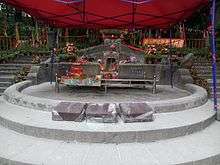Chiwan
Chiwan (Chinese: 赤湾) is a bay area south of Xiaonanshan hill, in Nanshan district, Shenzhen city, China.
Chiwan Port

Port of Chiwan
Chiwan Port (Chinese: 赤湾港) or Chiwan Container Terminal (Chinese: 赤湾集装箱码头) is part of the Port of Shenzhen. CCT is a sino-foreign joint venture company invested by Chiwan Wharf Holdings Limited、Kerry Properties (HK) Limited、China Merchants Holdings (International) Co.,Ltd and Modern Terminal Limited (Modern Terminals). The port of Chiwan is used by ships for crew changes, especially container ships, bulk carriers, OSVs - offshore supply and support vessels and off shore craft involved in the exploration of oil in the South China Sea.[1]
Historic structures
Chiwan Tianhou Temple
Chiwan Left Fort

Songshaodi's Tomb
- Chiwan Left Fort (Chinese:赤湾左炮台) is located on Yingzui Hill, Chiwan. It was constructed in 1717 and was among the forts used by Lin Zexu during the First Opium War [2][3]
- Chiwan Tianhou Temple (Chinese:赤湾天后宫) dates back to the Song Dynasty. It was said to be built as an offering to Mazu for protecting the fleet of Zheng He. It was rebuilt over the following centuries and the present structure was constructed in the early 1990s. It is currently the largest temple complex dedicated to Tianhou in Guangdong.[4][5]
- Song Shaodi's Tomb (Chinese:宋少帝陵) is the tomb of the last Song Dynasty Emperor, the 8-year-old Emperor Bing.[6][7]
- Chiwan Beacon (Chinese: 赤湾烟墩), built in 1394 at the peak of Xiaonanshan hill, was used in the following centuries as an important military facility to issue alerts for upcoming military attack. It is a good view point of the whole Chiwan bay and surrounding areas including Qianhai FTZ and Neilingding island. Hong Kong airport is also visable in a clear day.
See also
- Shekou, a residential and formerly industrial area east of Chiwan
- Chiwan Station, the Shenzhen Metro station serving the area
References
- ↑ Admiralty Sailing Directions - China Sea and Yellow Sea. Taunton, United Kingdom: UK Hydrographic Office. 2011.
- ↑ "Chiwan Left Fort". Retrieved 9 April 2016.
- ↑ "Home › Sightseeing › Historical Sites › Chiwan Left Fort". Retrieved 9 April 2016.
- ↑ "Chiwan Tianhou Temple (or Mazu Temple)". Retrieved 9 April 2016.
- ↑ "Tianhou Temple". Retrieved 9 April 2016.
- ↑ "宋少帝陵". Retrieved 9 April 2016.
- ↑ "Song Shao Di Mu, Tomb of the Last Song Emperor". Retrieved 9 April 2016.
External links
This article is issued from Wikipedia - version of the 11/4/2016. The text is available under the Creative Commons Attribution/Share Alike but additional terms may apply for the media files.